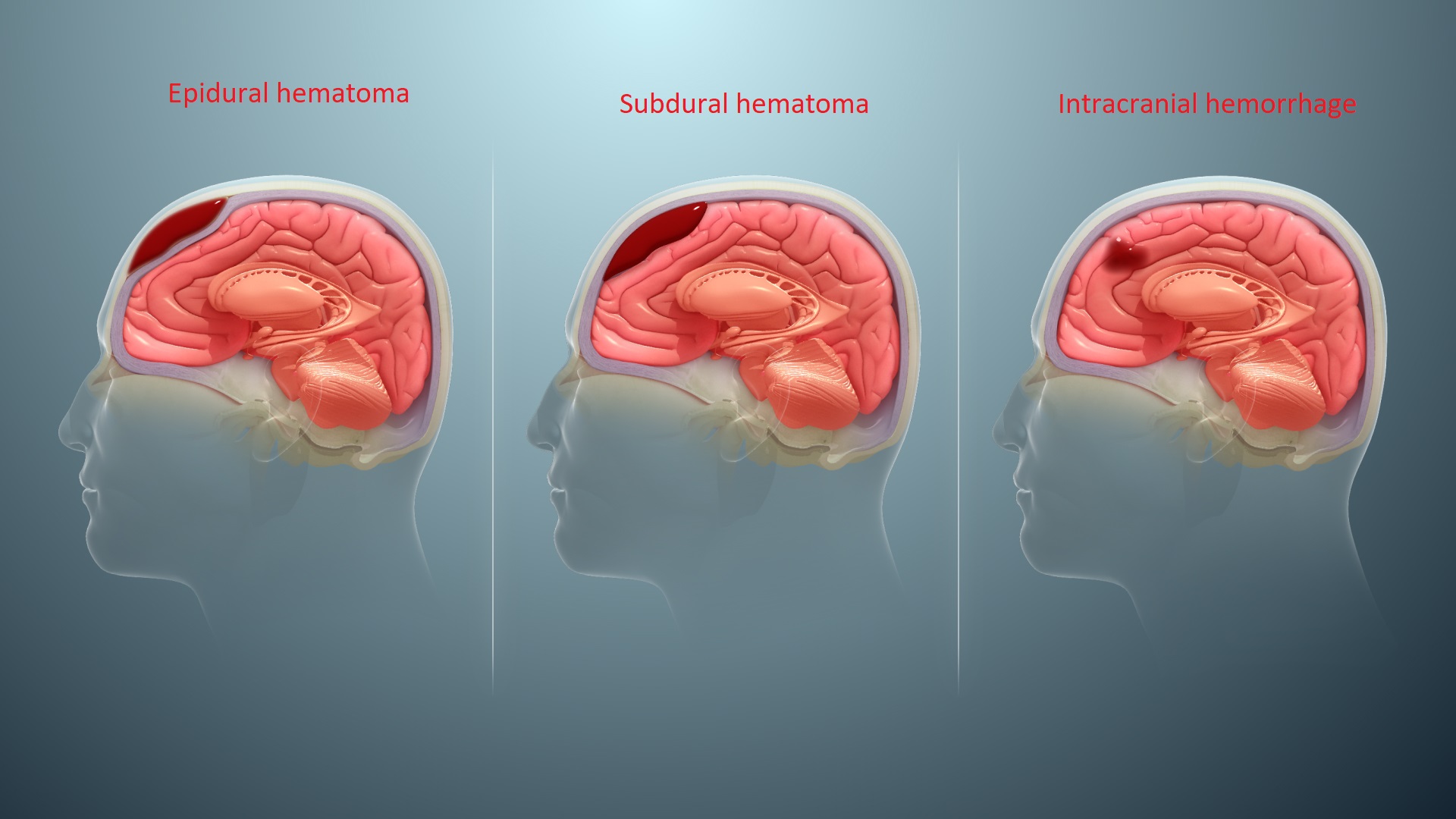Subdural hematoma pathophysiology
|
Subdural Hematoma Microchapters |
|
Diagnosis |
|---|
|
Treatment |
|
Case Studies |
|
Subdural hematoma pathophysiology On the Web |
|
American Roentgen Ray Society Images of Subdural hematoma pathophysiology |
|
Risk calculators and risk factors for Subdural hematoma pathophysiology |
Editor-In-Chief: C. Michael Gibson, M.S., M.D. [1] Associate Editor(s)-in-Chief: , Fahimeh Shojaei, M.D.
Overview
It is understood that subdural hematoma is the result of rupture in bridging veins (mostly due to head trauma) and hemorrhage between dura matter and arachnoid, leading to subdural hematoma, or rupture of small cortical atreries and hemorrhage into the space between dura matter and arachnoid, leading to subdural hematoma or intracranial hypotension (mostly due to lumbar punctue) and traction of bridging veins which leads to subdural hematoma. Genes involved in the pathogenesis of subdural hematoma include ADPKD, osteogenesis imperfecta, fabry's disease, mucopolysaccharidosis IIIB, and type B Niemann–Pick disease. On gross pathology, crescentic shape blood in the subdural potential space are characteristic findings of subdural hematoma. On microscopic histopathological analysis, blood in subdural space is characteristic findings of subdural hematoma.
Pathophysiology
Physiology
The normal physiology of bridging veins can be understood as follows:[1]
- In embryonic period, there is lots of anastomosis between brain and dura matter venous drainage.
- After 12 weeks of gestation these anastomosis will disappear and what is left from them create bridging veins.
- These vein s will drain venous blood from underlying brain tissue to the dural sinuses.

Pathogenesis
- It is understood that subdural hematoma is the result of:
- Rupture in bridging veins (mostly due to head trauma) and hemorrhage between dura matter and arachnoid, leading to subdural hematoma.
- Rupture of small cortical atreries and hemorrhage into the space between dura matter and arachnoid, leading to subdural hematoma.
- Intracranial hypotension (mostly due to lumbar punctue) and traction of bridging veins which leads to subdural hematoma
- Subdural hematomas as a result of arterial rupture accounts for 20% of SDH cases and are mostly in temporoparietal region.
- Since most of the SDH cases are due to vein rupture, the bleeding will stop on its own as a result of a clot formation or increased intracranial pressure.

Genetics
Genes involved in the pathogenesis of subdural hematoma include:
- ADPKD[2][3][4][5][6]
- Osteogenesis imperfecta
- Fabry's disease
- Mucopolysaccharidosis IIIB
- Type B Niemann–Pick disease
Associated Conditions
Conditions associated with subdural hematoma include:[7][8][9][10][11][12][13][14][15]
- Elderly
- Anticoagulant use
- Alcoholics
- Seizure
- CSF shunt
- Arachnoid cyst
- Meningioma
- Cocaine
- Dural metastase
- Roller coaster
Gross Pathology
On gross pathology, crescentic shape blood in the subdural potential space are characteristic findings of subdural hematoma.
Microscopic Pathology
On microscopic histopathological analysis, blood in subdural space is characteristic findings of subdural hematoma.


References
- ↑ Famaey, Nele; Ying Cui, Zhao; Umuhire Musigazi, Grace; Ivens, Jan; Depreitere, Bart; Verbeken, Erik; Vander Sloten, Jos (2015). "Structural and mechanical characterisation of bridging veins: A review". Journal of the Mechanical Behavior of Biomedical Materials. 41: 222–240. doi:10.1016/j.jmbbm.2014.06.009. ISSN 1751-6161.
- ↑ McGovern, Margaret M.; Lippa, Natalie; Bagiella, Emilia; Schuchman, Edward H.; Desnick, Robert J.; Wasserstein, Melissa P. (2013). "Morbidity and mortality in type B Niemann–Pick disease". Genetics in Medicine. 15 (8): 618–623. doi:10.1038/gim.2013.4. ISSN 1098-3600.
- ↑ Pirson, Yves (2010). "Extrarenal Manifestations of Autosomal Dominant Polycystic Kidney Disease". Advances in Chronic Kidney Disease. 17 (2): 173–180. doi:10.1053/j.ackd.2010.01.003. ISSN 1548-5595.
- ↑ Mitsias, Panyiotis; Levine, Steven R. (1996). "Cerebrovascular complications of Fabry's disease". Annals of Neurology. 40 (1): 8–17. doi:10.1002/ana.410400105. ISSN 0364-5134.
- ↑ Groninger, Anja; Schaper, Jörg; Messing-Juenger, Martina; Mayatepek, Ertan; Rosenbaum, Thorsten (2005). "Subdural hematoma as clinical presentation of osteogenesis imperfecta". Pediatric Neurology. 32 (2): 140–142. doi:10.1016/j.pediatrneurol.2004.07.011. ISSN 0887-8994.
- ↑ Aydin M, Akarsu S, Kabakus N, Akpolat N (May 2006). "Mucopolysaccharidosis IIIB, cerebral vasculopathy and recurrent subdural hematoma". Indian Pediatr. 43 (5): 437–40. PMID 16735769.
- ↑ Okuno S, Touho H, Ohnishi H, Karasawa J (August 1999). "Falx meningioma presenting as acute subdural hematoma: case report". Surg Neurol. 52 (2): 180–4. PMID 10447287.
- ↑ Koerbel A, Ernemann U, Freudenstein D (July 2005). "Acute subdural haematoma without subarachnoid haemorrhage caused by rupture of an internal carotid artery bifurcation aneurysm: case report and review of literature". Br J Radiol. 78 (931): 646–50. doi:10.1259/bjr/60601877. PMID 15961850.
- ↑ Fukutake, T.; Mine, S.; Yamakami, I.; Yamaura, A.; Hattori, T. (2000). "Roller coaster headache and subdural hematoma". Neurology. 54 (1): 264–264. doi:10.1212/WNL.54.1.264. ISSN 0028-3878.
- ↑ Keller, Thomas M.; Chappell, E.Thomas (1997). "Spontaneous acute subdural hematoma precipitated by cocaine abuse: Case report". Surgical Neurology. 47 (1): 12–14. doi:10.1016/S0090-3019(96)00380-1. ISSN 0090-3019.
- ↑ Bergmann M, Puskas Z, Kuchelmeister K (1992). "Subdural hematoma due to dural metastasis: case report and review of the literature". Clin Neurol Neurosurg. 94 (3): 235–40. PMID 1327614.
- ↑ Doherty DL (July 1988). "Posttraumatic cerebral atrophy as a risk factor for delayed acute subdural hemorrhage". Arch Phys Med Rehabil. 69 (7): 542–4. PMID 3389997.
- ↑ Zwimpfer, Thomas J.; Brown, Jennifer; Sullivan, Irene; Moulton, Richard J. (1997). "Head injuries due to falls caused by seizures: a group at high risk for traumatic intracranial hematomas". Journal of Neurosurgery. 86 (3): 433–437. doi:10.3171/jns.1997.86.3.0433. ISSN 0022-3085.
- ↑ Hylek, Elaine M. (1994). "Risk Factors for Intracranial Hemorrhage in Outpatients Taking Warfarin". Annals of Internal Medicine. 120 (11): 897. doi:10.7326/0003-4819-120-11-199406010-00001. ISSN 0003-4819.
- ↑ Chen, Joseph C.T.; Levy, Michael L. (2000). "Causes, Epidemiology, and Risk Factors of Chronic Subdural Hematoma". Neurosurgery Clinics of North America. 11 (3): 399–406. doi:10.1016/S1042-3680(18)30101-3. ISSN 1042-3680.